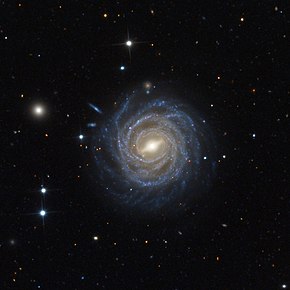NGC 521
| NGC 521 | |
|---|---|
 NGC 521 as seen on an image recorded the Mount Lemmon Observatory using the 32-inch Schulman reflecting telescope in 2015 | |
| Observation data (J2000[1] epoch) | |
| Constellation | Cetus[2] |
| Right ascension | 01h 24m 33.8s[3] |
| Declination | +01° 24′ 33.8″[3] |
| Redshift | 0.016902[1] |
| Heliocentric radial velocity | 5024.3 km/s[1] |
| Distance | 224 Mly[4] |
| Apparent magnitude (V) | 11.7[2] |
| Apparent magnitude (B) | 12.5[2] |
| Characteristics | |
| Type | SBbc[2] |
| Apparent size (V) | 2.7' × 2.4'[2] |
| Other designations | |
| PGC 5190, UGC 962, GC 304, MGC +00-04-118, 2MASS J01243377+0143532, h 115, IRAS 01219+0128[1][5] | |

NGC 521, also occasionally referred to as PGC 5190 or UGC 962, is a barred spiral galaxy located approximately 224 million light-years from the Solar System[4] in the constellation Cetus.[2] It was discovered on 8 October 1785 by astronomer William Herschel.[5]
Observation history
[edit]Historic observation
[edit]Herschel described his discovery as "faint, pretty large, irregular round, brighter middle". Further observations were made by both his son, John Herschel, who simply noted "big" on his first and "very faint" on his second observation, as well as R. J. Mitchell, who noted "pretty big, spiral galaxy, disc enveloped in faint outlying neby and looks like an unresolved cluster."[6] NGC 521 was later catalogued by John Louis Emil Dreyer in the New General Catalogue, where the galaxy was described as "faint, pretty large, round, gradually brighter middle".[5]
Supernovae
[edit]A total of three supernovae have been assigned to NGC 521, with SN 1966G being the first to be observed in 1966,[7] followed by SN 1982O in 1982[8] and the most recent being SN 2006G in 2006.[9]
Description
[edit]The galaxy's large apparent size can be attributed to the fact that it is face-on. Despite its size, it only has an apparent visual magnitude of 11.7. It can be classified as spiral galaxy of type SBbc using the Hubble Sequence.[2] The object's distance of roughly 220 million light-years from the Solar System can be estimated using its redshift and Hubble's law.[4]
See also
[edit]References
[edit]- ^ a b c d "NGC 521". SIMBAD. Centre de données astronomiques de Strasbourg. Retrieved 2017-12-09.
- ^ a b c d e f g "Revised NGC Data for NGC 521". spider.seds.org. Retrieved 2017-10-05.
- ^ a b "Your NED Search Results". ned.ipac.caltech.edu. Retrieved 2017-10-05.
- ^ a b c An object's distance from Earth can be determined using Hubble's law: v=Ho is Hubble's constant (70±5 (km/s)/Mpc). The relative uncertainty Δd/d divided by the distance is equal to the sum of the relative uncertainties of the velocity and v=Ho
- ^ a b c "New General Catalog Objects: NGC 500 - 549". cseligman.com. Retrieved 2017-10-16.
- ^ "astronomy-mall.com/Adventures.In.Deep.Space/NGC%201-7840%20complete.htm".
- ^ "Your NED Search Results". ned.ipac.caltech.edu. Retrieved 2018-01-24.
- ^ "Your NED Search Results". ned.ipac.caltech.edu. Retrieved 2018-01-24.
- ^ "Your NED Search Results". ned.ipac.caltech.edu. Retrieved 2018-01-24.
External links
[edit]- NGC 521 on WikiSky: DSS2, SDSS, GALEX, IRAS, Hydrogen α, X-Ray, Astrophoto, Sky Map, Articles and images
- SEDS
